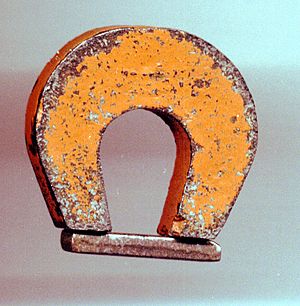Alnico facts for kids
Alnico is a special type of metal mix, called an alloy. It's mostly made of iron, but also has aluminium (Al), nickel (Ni), and cobalt (Co). Its name, Alnico, comes from the first letters of these elements: Al-Ni-Co. Sometimes, it might also have a bit of copper or titanium.
Alnico alloys are "ferromagnetic". This means they can be turned into strong, permanent magnets. They are good at holding onto their magnetism, so they make great permanent magnets. Before the 1970s, when new "rare-earth magnets" were invented, Alnico magnets were the strongest magnets around!
A scientist named T. Mishima in Japan first discovered Alnico in 1931. He found that mixing iron, nickel, and aluminum made a magnet twice as strong as any other magnet back then.
Contents
What Makes Alnico Special?
You can turn Alnico into a magnet by putting it in a very strong magnetic field. Only "rare-earth magnets" like neodymium and samarium-cobalt are usually stronger than Alnico magnets.
How Strong Are Alnico Magnets?
Alnico magnets create very strong magnetic fields at their ends, called "poles." These fields can be as strong as 1500 Gauss (which is 0.15 tesla). That's about 3000 times stronger than Earth's own magnetic field!
Different Types of Alnico
Some types of Alnico magnets are "isotropic". This means their magnetic properties are the same in all directions. You can magnetize them equally well from any side.
Other types, like Alnico 5 and Alnico 8, are "anisotropic". This means their magnetic properties are different depending on the direction. These types have a "preferred direction" for magnetism. If you magnetize them in this special direction, they will become even stronger than isotropic Alnico magnets.
Heat and Cost
Alnico magnets are special because they can still work well even when they get very hot, even "red-hot"!
In 2008, Alnico magnets cost about $44 per kilogram (or $20 per pound).
Images for kids
-
Advertisement by Jensen Radio Manufacturing Co. for Alnico 5 loudspeakers in 1945. Alnico 5 helped make magnets much smaller and lighter for the same power.
See also
 In Spanish: Alnico para niños
In Spanish: Alnico para niños




